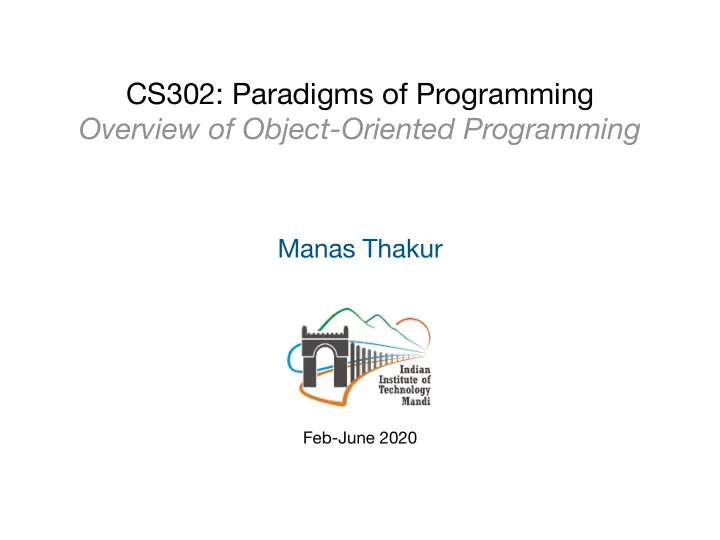

CS302: Paradigms of Programming Overview of Object-Oriented Programming Manas Thakur Feb-June 2020
Credits • Some images have been taken from the “texinfo” format of “Structure and Interpretation of Computer Programs”, Second Edition, Universities Press, 2005; authors: Harold Abelson, Gerald Jay Sussman and Julie Sussman. 2
What all do you associate with OOP? • Objects! 1. Ability to group multiple items into a single abstraction 2. Ability to create multiple objects of a certain kind 3. Ability to perform operations on the object abstraction 4. Ability to say that some objects are like others in some sense but di ff erent in their own ways • Let’s handle these abilities one by one. 3
1. Ability to group multiple items into a single abstraction • Structures in C; Classes in C++/Java • What about in Scheme? (define (make-rat x y) (lambda (which) (if (= which 0) x y))) • We already know how to create classes in Scheme! 4
2. Ability to create multiple objects of a certain kind • Constructors in C++/Java • Yes sir, we’ve already got ’em! (define (make-rat x y) (lambda (which) (if (= which 0) x y))) (define n1 (make-rat 2 3)) (define n2 (make-rat 3 4)) • Reckon that both n1 and n2 hold di ff erent “fields” (again due to the existence of closures!). 5
3. Ability to perform operations on the object abstraction • Functions/Methods in C++/Java • In Scheme? • Yeh to pehli class se padha rahe hain! (define (make-rat x y) (lambda (which) (if (= which 0) x y))) (define (numer n) (n 0)) (define (denom n) (n 1)) (define (mult-rat n1 n2) (make-rat (* (numer n1) (numer n2)) (* (denom n1) (denom n2)))) 6
Let’s compare… class Rational { int x; int y; (define (make-rat x y) (lambda (which) (if (= which 0) x y))) Rational(int x, int y) { this.x = x; this.y = y; } (define (numer n) (n 0)) (define (denom n) (n 1)) int numer() { return x; } (define (mult-rat n1 n2) int denom() { return y; } (make-rat (* (numer n1) (numer n2)) Rational mult-rat(Rational other) { (* (denom n1) return new Rational( (denom n2)))) this.numer() * other.numer(), this.denom() * other.denom()); (define n1 (make-rat 2 3)) } (define n2 (make-rat 3 4)) } (define n3 (mult-rat n1 n2)) Rational n1 = new Rational(2,3); Rational n2 = new Rational(3,4); Rational n3 = n1.mult-rat(n2); 7
What all does our Scheme version lack? (define (make-rational x y) (lambda (which) • Packaging (if (= which 0) x y))) (define (numer n) (n 0)) (define (denom n) (n 1)) (define (mult-rat n1 n2) • Encapsulation of the defined (make-rat (* (numer n1) (numer n2)) functions/methods into a module (* (denom n1) (denom n2)))) (define n1 (make-rat 2 3)) (define n2 (make-rat 3 4)) • Dispatch on objects (define n3 (mult-rat n1 n2)) class Rational { int x; int y; • Aka message passing Rational(int x, int y) { this.x = x; this.y = y; } int numer() { return x; } • And the complete miss on point 4 int denom() { return y; } Rational mult-rat(Rational other) { from Slide 2! return new Rational( this.numer() * other.numer(), this.denom() * other.denom()); • We’ll learn how to address all of } } these and more — in Scheme! Rational n1 = new Rational(2,3); Rational n2 = new Rational(3,4); Rational n3 = n1.mult-rat(n2); 8
The rabbit asked the king, “Where shall I begin, please your Majesty?”. The king replied gravely, “Begin at the beginning.” 9
Let’s begin with complex numbers • Two representations: • Rectangular (real and imaginary) • Polar (magnitude and angle) • Which one to choose? • Addition/subtraction easier using rectangular representation: real-part(z1+z2) = real-part(z1) + real-part(z2) img-part(z1+z2) = img-part(z1) + img-part(z2) • Multiplication/division easier using polar representation: magnitude(z1*z2) = magnitude(z1) * magnitude(z2) angle(z1*z2) = angle(z1) + angle(z2) 10
Let’s choose both the representations • Rectangular complex numbers: 11
Let’s choose both the representations • Polar complex numbers: 12
What about the operations? • Do not depend on the representation! 13
But now we have a problem! • We have two di ff erent selectors with the same name: (define (real-part z) (car z)) (define (real-part z) (* (magnitude z) (cos (angle z)))) • Which one should be called? (define (add-complex z1 z2) (make-from-real-imag (+ (real-part z1) (real-part z2)) (+ (imag-part z1) (imag-part z2)))) • Topic for the next class! ( Thursday, tomorrow, 11 am ) 14
Recommend
More recommend